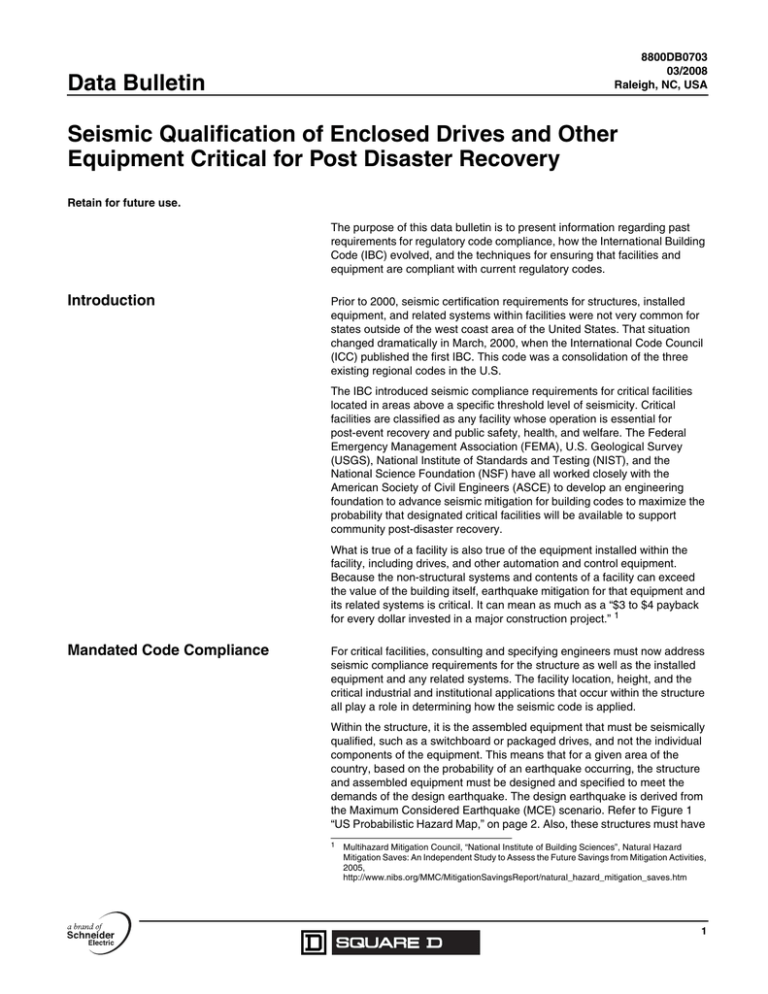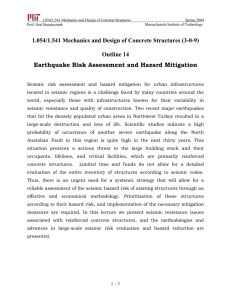
8800DB0703
03/2008
Raleigh, NC, USA
Data Bulletin
Seismic Qualification of Enclosed Drives and Other
Equipment Critical for Post Disaster Recovery
Retain for future use.
The purpose of this data bulletin is to present information regarding past
requirements for regulatory code compliance, how the International Building
Code (IBC) evolved, and the techniques for ensuring that facilities and
equipment are compliant with current regulatory codes.
Introduction
Prior to 2000, seismic certification requirements for structures, installed
equipment, and related systems within facilities were not very common for
states outside of the west coast area of the United States. That situation
changed dramatically in March, 2000, when the International Code Council
(ICC) published the first IBC. This code was a consolidation of the three
existing regional codes in the U.S.
The IBC introduced seismic compliance requirements for critical facilities
located in areas above a specific threshold level of seismicity. Critical
facilities are classified as any facility whose operation is essential for
post-event recovery and public safety, health, and welfare. The Federal
Emergency Management Association (FEMA), U.S. Geological Survey
(USGS), National Institute of Standards and Testing (NIST), and the
National Science Foundation (NSF) have all worked closely with the
American Society of Civil Engineers (ASCE) to develop an engineering
foundation to advance seismic mitigation for building codes to maximize the
probability that designated critical facilities will be available to support
community post-disaster recovery.
What is true of a facility is also true of the equipment installed within the
facility, including drives, and other automation and control equipment.
Because the non-structural systems and contents of a facility can exceed
the value of the building itself, earthquake mitigation for that equipment and
its related systems is critical. It can mean as much as a “$3 to $4 payback
for every dollar invested in a major construction project.” 1
Mandated Code Compliance
For critical facilities, consulting and specifying engineers must now address
seismic compliance requirements for the structure as well as the installed
equipment and any related systems. The facility location, height, and the
critical industrial and institutional applications that occur within the structure
all play a role in determining how the seismic code is applied.
Within the structure, it is the assembled equipment that must be seismically
qualified, such as a switchboard or packaged drives, and not the individual
components of the equipment. This means that for a given area of the
country, based on the probability of an earthquake occurring, the structure
and assembled equipment must be designed and specified to meet the
demands of the design earthquake. The design earthquake is derived from
the Maximum Considered Earthquake (MCE) scenario. Refer to Figure 1
“US Probabilistic Hazard Map,” on page 2. Also, these structures must have
1
Multihazard Mitigation Council, “National Institute of Building Sciences”, Natural Hazard
Mitigation Saves: An Independent Study to Assess the Future Savings from Mitigation Activities,
2005,
http://www.nibs.org/MMC/MitigationSavingsReport/natural_hazard_mitigation_saves.htm
1
Seismic Qualification of Enclosed Drives and Other Equipment Critical for Post Disaster Recovery
Mandated Code Compliance
8800DB0703
03/2008
a high probability of being restored to essential operational status with only
minor repairs.
US Probabilistic Hazard Map 2
Figure 1:
125
0.2 sec S.A. (%g) with 2% Probability of Exceedance in 50 Years
W
65˚
N
120˚
USGS Map, Oct. 2002rev
50˚
W
0˚W
˚W
115˚W
110˚W
105˚W 100˚W
95˚W
90˚W
85˚W
75˚W
80˚W
12
N
45˚
7
600
400
320
240
40
50˚
N
45˚
N
160
120
100
80
20
40
8
40
40˚
N
40˚
40
N
60
40
0
14
16
12
N
35˚
20
60
116401
0
12
12
0
16
20
30˚
N
12
16
20
N
4
125
˚W
12
N
25˚
8
12 8
16
16
40
20
16
20
12
25˚
W
65˚
4
120˚
W
115˚W
110˚W
105˚W
24
20
N
30˚
40
40
36
32
28
40
8
0
1146
00
N
20
120 1
35˚
16
12
100˚W
95˚W
90˚W
85˚W
8
4
0
70˚W
80˚W
75˚W
This site-specific design criteria must be determined by a structural design
professional registered in the location where the project is planned. To do
this, the design professional follows a code-defined process to establish the
basis of seismic design for the facility. This process includes determining:
2
•
The occupancy category, which establishes the intended use of the
building
•
The level of seismicity, which is determined by code-referenced seismic
hazard maps and geotechnical soil condition, or by an extensive site
specific custom engineering study
•
The foundation soil classification, which is determined by site-specific
geotechnical reports, or otherwise as described by code
•
•
The code-mandated limitations on building type and structural system
Increases in the structural force-resisting capability to maximize
post-event structural integrity
•
The location within the facility where the installed equipment and related
systems reside, from grade level to roof top. The information relating to
installation location is used to determine increased equipment
qualification criteria.
•
The classification of the system as a “seismic designated system” if it is
essential for post-event recovery and facility operation, or if its failure
could have a negative impact on essential systems.
2
Citation: Frankel, A., C. Mueller, T. Barnhard, D. Perkins, E. V. Leyendecker, N. Dickman. S. Hanson, and
M. Hopper, 1996, National seismic hazard maps:, U.S. Geological Survey Open File Report 96-532,
© 2008 Schneider Electric All Rights Reserved
8800DB0703
03/2008
Seismic Qualification of Enclosed Drives and Other Equipment Critical for Post Disaster Recovery
Seismic Testing for Drives and Other Components
Seismic Testing for Drives and
Other Components
The installer uses criteria established by the structural design professional
to ensure that building components such as packaged drives, motor control
centers, switchboards, and even light fixtures are tested and certified to
withstand a seismic event. Seismic ratings are particularly important for all
of the electronic equipment that is part of a seismic designated system in
facilities such as hospitals and water treatment plants, as well as schools
and other government buildings designated as essential for post-disaster
recovery. These facilities must be operational after a catastrophic event.
Therefore, the equipment must be designed to withstand the violent forces
of an earthquake and come back online with only minor repair.
It is especially critical that drives be tested and certified to withstand seismic
events, as they are becoming an integral component of critical facilities and
lifeline systems. The ever improving cost-to-performance of drives positions
them to provide superior system solutions with improved stability in
response to system transients and energy efficiency over mechanical
dampers and valves.
Due to the fact that packaged drives are becoming more integral to
post-event system operational reliability, it is essential that they have a
proven ability to absorb the unusual physical demands of seismic loads and
still have a high probability of operating after an earthquake event.
Therefore, these drives must be subjected to a rigorous seismic qualification
program. The consulting engineer specifying the drives must ensure that
they include the IBC-required certificate of compliance with the seismic
requirements of the location. It is critically important that the engineers,
system integrators, and facility managers know exactly where the
equipment is being installed, possible seismic activity in the location, and
whether or not the drives are qualified for the seismic risk. The potential for
equipment to be moved to another facility in a different region should also
be considered. Electronic equipment, especially drives, should be clearly
documented by the manufacturer to include the level of seismic activity for
which the components have been qualified.
To use equipment, including packaged drives, which does not have the
IBC-mandated certificate of compliance, burdens all parties with an
unnecessary risk. Obtaining qualified service personnel, parts, or
replacements can be difficult, if not impossible, during the first few days or
weeks after a significant natural disaster. Therefore, using non-compliant
equipment is a risk that should be avoided.
Advantages of Shake Table
Qualification
© 2008 Schneider Electric All Rights Reserved
When possible, the preferred method to determine seismic qualifications for
electrical equipment is by shake table testing. This test is performed by
anchoring the equipment at the hard points to a shake table which moves in
three axes simultaneously to replicate worst-case earthquake scenarios.
Shake table testing typically uses a 30-second random time history of full
motion to envelope a wide range of possible earthquake motions.
3
Seismic Qualification of Enclosed Drives and Other Equipment Critical for Post Disaster Recovery
Advantages of Shake Table Qualification
Figure 2:
8800DB0703
03/2008
18-Pulse device mounted to test stand at Wyle Labs
When shake table tests are conducted in accordance with ICC ES AC156,
the first industry qualification protocol developed specifically to translate
building code seismic requirements into a shake table test, the result is
earthquake-, building-, and site-independent, which means that it is not
specific to any one application. Once the testing is complete, the results
indicate the product qualification design issues that the consulting engineer
must resolve when the components are installed in the structure. The
tri-axial shake table earthquake simulation subjects the equipment to
dynamic demand that can be more severe than the code design earthquake
for most locations. As long as the qualified equipment is installed, anchored,
and restrained in accordance with the manufacturer’s guidelines regarding a
seismic restraint system that is code compliant, the test is certified as
compliant to the ICC ES AC156 protocol criteria for the applicable code.
If equipment is too large for the shake table test, an accepted industry
practice is to perform qualification through rigorous analysis. This is a
time-consuming and engineering-intensive activity. The only other code
recognized option is qualification by experience, but this is also an
engineering-intensive process and can be problematic due to the number of
conditions that must be satisfied and the lack of an up-to-date equipment
database, which is required to validate data relevancy.
The preferred proof of compliance is the shake table test which should be
used whenever possible. 3
3
Schneider Electric USA
8001 Highway 64 East
Knightdale, NC 27545
1-888-SquareD (1-888-778-2733)
www.us.SquareD.com
FEMA 450-1, -2, National Earthquake Hazards Reduction Program, Part 2: Commentary, 2003,
http://www.bssconline.org/
Electrical equipment should be installed, operated, serviced, and maintained only by
qualified personnel. No responsibility is assumed by Schneider Electric for any
consequences arising out of the use of this material.
© 2008 Schneider Electric All Rights Reserved





